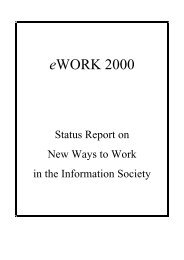Proceedings of 8th European Assembly on telework (Telework2001)
Proceedings of 8th European Assembly on telework (Telework2001)
Proceedings of 8th European Assembly on telework (Telework2001)
You also want an ePaper? Increase the reach of your titles
YUMPU automatically turns print PDFs into web optimized ePapers that Google loves.
203Challenges for Programmatic Workplace DevelopmentThe themes <str<strong>on</strong>g>of</str<strong>on</strong>g> the knowledge-based ec<strong>on</strong>omy have not featured visibly in <str<strong>on</strong>g>European</str<strong>on</strong>g> countriesin recent workplace development programmes, whether completed or <strong>on</strong>going. This is indirectlyevident in the fact that the companies and workplaces included in these programmes operate largelyin traditi<strong>on</strong>al sectors (Alasoini 2000a; Business Decisi<strong>on</strong>s Limited 2000). Although innovativecompanies can be found in all sectors, it might be assumed that companies specifically in the new,dynamic, rapidly expanding sectors would be the best laboratories for testing new types <str<strong>on</strong>g>of</str<strong>on</strong>g> work,organizati<strong>on</strong>al and human resource management practices, which could be an important source<str<strong>on</strong>g>of</str<strong>on</strong>g> inspirati<strong>on</strong> also for the traditi<strong>on</strong>al sectors and help support better integrati<strong>on</strong> between the‘new’ and the ‘old’ ec<strong>on</strong>omy (Prihti et al. 2000, 41-43). Experiences in Finland have, however,shown that, due to their rapid pace <str<strong>on</strong>g>of</str<strong>on</strong>g> change and lack <str<strong>on</strong>g>of</str<strong>on</strong>g> firmly established operating procedures,these companies (<str<strong>on</strong>g>of</str<strong>on</strong>g> many <str<strong>on</strong>g>of</str<strong>on</strong>g> them are in the ICT cluster) find it hard to commit to l<strong>on</strong>g-termprogrammatic development (Alasoini 2000b, 115-118; Kasvio et al. 2000, 140-141). The absence<str<strong>on</strong>g>of</str<strong>on</strong>g> these types <str<strong>on</strong>g>of</str<strong>on</strong>g> company may at worst lead to two legitimacy problems when we c<strong>on</strong>sider the role<str<strong>on</strong>g>of</str<strong>on</strong>g> these programmes as part <str<strong>on</strong>g>of</str<strong>on</strong>g> a nati<strong>on</strong>al or regi<strong>on</strong>al innovati<strong>on</strong> policy:• The programmes do not make for better integrati<strong>on</strong> <str<strong>on</strong>g>of</str<strong>on</strong>g> the basic values <str<strong>on</strong>g>of</str<strong>on</strong>g> workplace developmentpolicy into the work processes and assignments, or organizati<strong>on</strong>al and human resource managementsoluti<strong>on</strong>s <str<strong>on</strong>g>of</str<strong>on</strong>g> companies in the ec<strong>on</strong>omy’s new growth sectors. Such values, specifically in a Nordiclabour market c<strong>on</strong>text, include broad participati<strong>on</strong> by employees, recogniti<strong>on</strong> <str<strong>on</strong>g>of</str<strong>on</strong>g> the need forbalanced development between pr<str<strong>on</strong>g>of</str<strong>on</strong>g>itability and employee well-being, and <str<strong>on</strong>g>of</str<strong>on</strong>g>fering employeesequal opportunities for pers<strong>on</strong>al and pr<str<strong>on</strong>g>of</str<strong>on</strong>g>essi<strong>on</strong>al development in c<strong>on</strong>necti<strong>on</strong> with changes,irrespective <str<strong>on</strong>g>of</str<strong>on</strong>g> gender, age, ethnicity or other factors. This problem is aggravated by the fact thatmany <str<strong>on</strong>g>of</str<strong>on</strong>g> the companies in the growing knowledge-based businesses aim to achieve the effect <str<strong>on</strong>g>of</str<strong>on</strong>g>‘increasing returns’, i.e. whoever gains advantage, ceteris paribus, gains further advantage (Arthur1999; Teece 2001). This new business logic may feed ‘winner-takes-all’ mentality and aggressiveapproach also in pers<strong>on</strong>nel policy; as the firm’s knowledge base (in terms <str<strong>on</strong>g>of</str<strong>on</strong>g> employee skills andcompetencies) grows the more it is used, it becomes increasingly tempting for the firm to strive toexploit skills and competencies <str<strong>on</strong>g>of</str<strong>on</strong>g> the ‘knowledge workers’ without any limitati<strong>on</strong>s.• In focusing <strong>on</strong> traditi<strong>on</strong>al sectors, the programmes may see the main problems <str<strong>on</strong>g>of</str<strong>on</strong>g> workplacedevelopment too much from the perspective <str<strong>on</strong>g>of</str<strong>on</strong>g> the old structures <str<strong>on</strong>g>of</str<strong>on</strong>g> workplaces and assignmentsabout to become replaced, leaving them little to c<strong>on</strong>tribute to the new, emerging structures. Touse the distincti<strong>on</strong> by Beck (2000), there is the danger that the programmes may try to solvethe problems <str<strong>on</strong>g>of</str<strong>on</strong>g> the ‘sec<strong>on</strong>d modernity’ by approaches designed for the problems <str<strong>on</strong>g>of</str<strong>on</strong>g> the ‘firstmodernity’, thus even promoting cognitive, political or structural ‘lock-ins’ (Schienstock 1999,45-46) in the search for new, innovative soluti<strong>on</strong>s.In the 1970s, the focus <str<strong>on</strong>g>of</str<strong>on</strong>g> workplace development policy was typically <strong>on</strong> problems arising fromTaylorist working arrangements being taken to extremes, such as the erg<strong>on</strong>omic and psychologicalproblems <str<strong>on</strong>g>of</str<strong>on</strong>g> repetitive and m<strong>on</strong>ot<strong>on</strong>ous work and the lack <str<strong>on</strong>g>of</str<strong>on</strong>g> aut<strong>on</strong>omy and influence. Theseproblems were tangible and clearly delimited in both the physical and the organizati<strong>on</strong>al sense, andit was <str<strong>on</strong>g>of</str<strong>on</strong>g>ten possible to find fairly simple soluti<strong>on</strong>s to them by applying the right expertise. Thesoluti<strong>on</strong>s in questi<strong>on</strong> were, furthermore, neutral in terms <str<strong>on</strong>g>of</str<strong>on</strong>g> effects, in that they did not usually havedirect employment impacts <strong>on</strong> the workplace c<strong>on</strong>cerned, or indirect impacts <strong>on</strong> employees outsidethat workplace.








